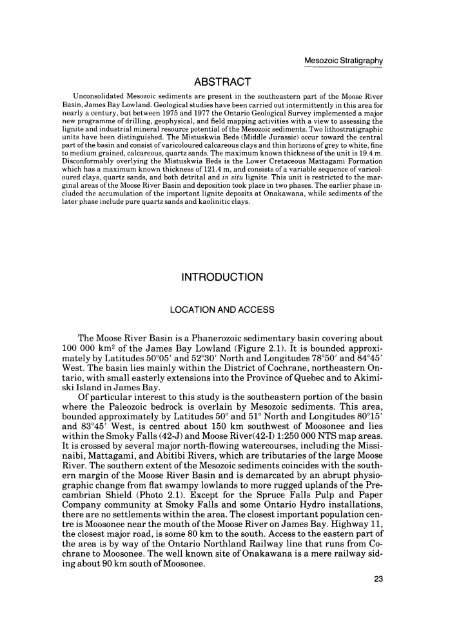Moose River Basin: geology and mineral potential - Geology Ontario
Moose River Basin: geology and mineral potential - Geology Ontario
Moose River Basin: geology and mineral potential - Geology Ontario
Create successful ePaper yourself
Turn your PDF publications into a flip-book with our unique Google optimized e-Paper software.
ABSTRACT<br />
Mesozoic Stratigraphy<br />
Unconsolidated Mesozoic sediments are present in the southeastern part of the <strong>Moose</strong> <strong>River</strong><br />
<strong>Basin</strong>, James Bay Lowl<strong>and</strong>. Geological studies have been carried out intermittently in this area for<br />
nearly a century, but between 1975 <strong>and</strong> 1977 the <strong>Ontario</strong> Geological Survey implemented a major<br />
new programme of drilling, geophysical, <strong>and</strong> field mapping activities with a view to assessing the<br />
lignite <strong>and</strong> industrial <strong>mineral</strong> resource <strong>potential</strong> of the Mesozoic sediments. Two lithostratigraphic<br />
units have been distinguished. The Mistuskwia Beds (Middle Jurassic) occur toward the central<br />
part of the basin <strong>and</strong> consist of varicoloured calcareous clays <strong>and</strong> thin horizons of grey to white, fine<br />
to medium grained, calcareous, quartz s<strong>and</strong>s. The maximum known thickness of the unit is 19.4 m.<br />
Disconformably overlying the Mistuskwia Beds is the Lower Cretaceous Mattagami Formation<br />
which has a maximum known thickness of 121.4 m, <strong>and</strong> consists of a variable sequence of varicol<br />
oured clays, quartz s<strong>and</strong>s, <strong>and</strong> both detrital <strong>and</strong> in situ lignite. This unit is restricted to the mar<br />
ginal areas of the <strong>Moose</strong> <strong>River</strong> <strong>Basin</strong> <strong>and</strong> deposition took place in two phases. The earlier phase in<br />
cluded the accumulation of the important lignite deposits at Onakawana, while sediments of the<br />
later phase include pure quartz s<strong>and</strong>s <strong>and</strong> kaolinitic clays.<br />
INTRODUCTION<br />
LOCATION AND ACCESS<br />
The <strong>Moose</strong> <strong>River</strong> <strong>Basin</strong> is a Phanerozoic sedimentary basin covering about<br />
100 000 km2 of the James Bay Lowl<strong>and</strong> (Figure 2.1). It is bounded approxi<br />
mately by Latitudes 50 005' <strong>and</strong> 52 030' North <strong>and</strong> Longitudes 78 050' <strong>and</strong> 84 045'<br />
West. The basin lies mainly within the District of Cochrane, northeastern On<br />
tario, with small easterly extensions into the Province of Quebec <strong>and</strong> to Akimiski<br />
Isl<strong>and</strong> in James Bay.<br />
Of particular interest to this study is the southeastern portion of the basin<br />
where the Paleozoic bedrock is overlain by Mesozoic sediments. This area,<br />
bounded approximately by Latitudes 500 <strong>and</strong> 51 0 North <strong>and</strong> Longitudes 80 015'<br />
<strong>and</strong> 83 045' West, is centred about 150 km southwest of Moosonee <strong>and</strong> lies<br />
within the Smoky Falls (42-J) <strong>and</strong> <strong>Moose</strong> <strong>River</strong>(42-I) 1:250 000 NTS map areas.<br />
It is crossed by several major north-flowing watercourses, including the Missi<br />
naibi, Mattagami, <strong>and</strong> Abitibi <strong>River</strong>s, which are tributaries of the large <strong>Moose</strong><br />
<strong>River</strong>. The southern extent of the Mesozoic sediments coincides with the south<br />
ern margin of the <strong>Moose</strong> <strong>River</strong> <strong>Basin</strong> <strong>and</strong> is demarcated by an abrupt physio<br />
graphic change from flat swampy lowl<strong>and</strong>s to more rugged upl<strong>and</strong>s of the Pre<br />
cambrian Shield (Photo 2.1). Except for the Spruce Falls Pulp <strong>and</strong> Paper<br />
Company community at Smoky Falls <strong>and</strong> some <strong>Ontario</strong> Hydro installations,<br />
there are no settlements within the area. The closest important population cen<br />
tre is Moosonee near the mouth of the <strong>Moose</strong> <strong>River</strong> on James Bay. Highway 11,<br />
the closest major road, is some 80 km to the south. Access to the eastern part of<br />
the area is by way of the <strong>Ontario</strong> Northl<strong>and</strong> Railway line that runs from Co<br />
chrane to Moosonee. The well known site of Onakawana is a mere railway sid<br />
ing about 90 km south of Moosonee.<br />
23

















